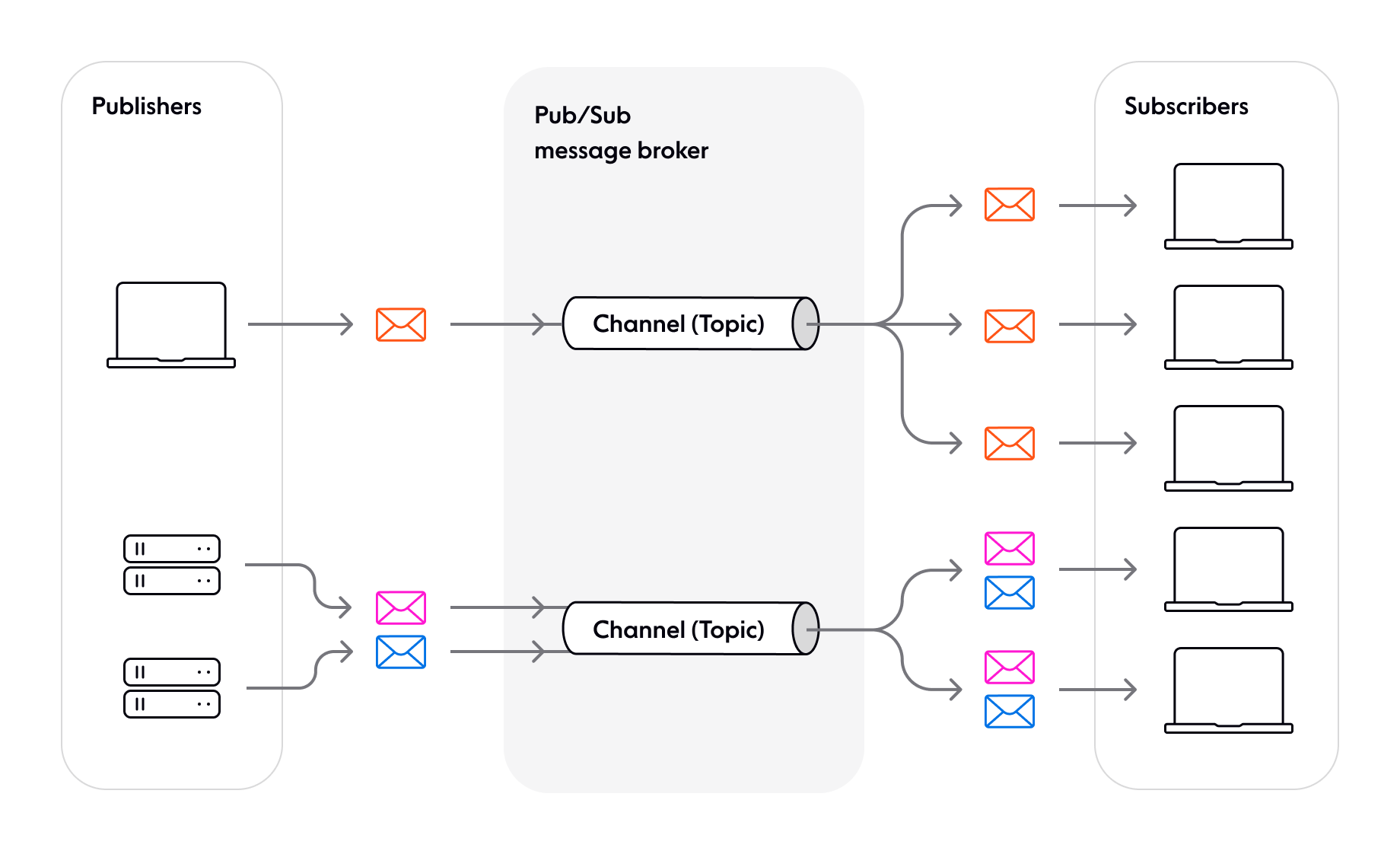- Topics
- /
- Design patterns
- /
- What are the benefits of Pub/Sub messaging?
What are the benefits of Pub/Sub messaging?
Pub/Sub is frequently used to engineer event-driven systems and realtime apps. This article explores the benefits that Pub/Sub messaging brings to the table, and how it helps simplify software development.
What is Pub/Sub?
Pub/Sub (or Publish/Subscribe) is an architectural design pattern used in distributed systems for asynchronous communication between different components or services. Although Publish/Subscribe is based on earlier design patterns like message queuing and event brokers, it is more flexible and scalable. The key to this is the fact that Pub/Sub enables the movement of messages between different components of the system without the components being aware of each other’s identity (they are decoupled).

The pub/sub pattern
Learn more about:
The benefits of Pub/Sub messaging
Building a system at scale using the Pub/Sub pattern benefits all stakeholders. The software development process benefits from the simplicity of the Pub/Sub pattern. Let’s look at these advantages from the software architects’, developers’, and testers’ points of view.
Benefits of Pub/Sub for software architects
Loose coupling between system components: The Pub/Sub pattern decouples communication logic and business logic, allowing the isolation of components. Isolated components make the system robust and keep the code maintainable.
Better view of the system-wide workflow: The premise of the Pub/Sub pattern is simple, so Pub/Sub systems are easier for software architects to refactor and expand.
Better & faster integration: Pub/Sub is programming language and communication protocol agnostic, which allows disparate components of a system to be integrated faster compared to legacy alternatives.
Smooth scalability: Systems using Pub/Sub are scalable without the fear of breaking functionality because communication logic and business logic are separate entities. Software architects can redesign the message broker’s topic architecture without the worry of breaking the business logic.
Guaranteed consistent reliability: The Pub/Sub pattern also helps in keeping the system reliable when features change. Pub/Sub supports asynchronous message delivery, which ensures reliable message delivery even when the message broker’s topic architecture changes.
Builds elasticity: Pub/Sub systems are elastic because the business logic does not depend on the number of active publishers and subscribers at an instance. In other words, Pub/Sub systems can accommodate a surge in usage.
Benefits of Pub/Sub for software developers
Software modularization: Systems built on Pub/Sub allow developers to split the system into modules based on the system’s business logic. Modularization and separation of concerns lead to better code.
Language-agnostic software development: The Pub/Sub pattern is used to make software development language-agnostic. The application is broken down into smaller, logical parts. Parts are programmed using a suitable programming language. The inter-communication between the parts takes place via Pub/Sub. In effect, Pub/Sub stitches the components into a single working software.
Clarity in business logic: The message broker takes the responsibility of reliably forwarding published messages to subscribers, thus freeing the developer from writing additional code. Codebase becomes simpler and reader-friendly.
Improves responsiveness: In the Pub/Sub software pattern, communication is asynchronous. It allows the modules to be also programmed asynchronously. Message delivery does not block the publisher. The publisher gets back to its task after publishing the message. Similarly, the subscriber gets interrupted only when there is a message on a subscribed channel (topic).
Benefits of Pub/Sub for software testers
Streamlined testing practices: Pub/Sub makes testing modular because business logic isn’t coupled to the message broker.
Improved debugging: In a Pub/Sub system, topics channel messages from publishers to subscribers. It is easier to monitor and inspect topics for debugging integration issues between modules.
Better unit testing framework: In a Pub/Sub system, a component under unit test cares only about the topic and messages on that topic. It does not care about external components at all. So, you can create a generic stub. The generic stub acts as an external component sending messages on a topic. Further, it can be replicated for all components - which is a better approach to building unit testing frameworks than having separate stubs for each component.
When to use Pub/Sub messaging
Pub/Sub’s loose coupling, asynchronous nature, and inherent scalability make it an excellent solution for distributed systems with a high and fluctuating number of publishers and subscribers. You can use Pub/Sub for many different purposes, such as:
Sending event notifications.
Distributed caching.
Distributed logging.
Working with multiple data sources.
Broadcasting updates (one-to-many messaging).
Building responsive, low-latency end-user experiences like live chat and multiplayer collaboration functionality.
Situations where Pub/Sub is a bad choice
While Pub/Sub is a useful communication pattern in many scenarios, there are situations where it might not be the best choice. Here are a few examples:
Overkill for simpler systems and small-scale applications that only need to communicate with a few other components or services.
Not suitable for audio and video streaming.
Inappropriate for periodic or background tasks.
Not ideal for non-event-driven systems and use cases where you need synchronous communication.
Should you use a Pub/Sub service?
If you choose the Pub/Sub route, it's essential that you can rely on the tooling you choose. For most teams, that means using a managed pub/sub platform rather than building a solution in-house.
In our own research, we've found that in-house realtime infrastructure projects have a strong tendency to run over budget and over time. And even after all that, they often cost more overall.
If you decide to use a managed Pub/Sub service though, you need to make sure it is fit for purpose. This means evaluating it based on scalability, reliability, performance (including latency), guarantees, ease of development, cost of ownership, and its ability to deliver functionality beyond Pub/Sub.
Thankfully, we have done a review of the five best Pub/Sub solutions to help you to compare their offerings.
Deliver realtime experiences at scale with Ably’s Pub/Sub messaging
Ably is a realtime PaaS. Our APIs and SDKs help developers ship realtime experiences like chat and multiplayer collaboration without having to worry about maintaining and scaling messy infrastructure.
Key Ably features and capabilities:
Pub/Sub messaging over serverless WebSockets, with rich features such as message delta compression, automatic reconnections with continuity, user presence, message history, and message interactions.
Multi-protocol capabilities; in addition to WebSockets, we support protocols like SSE, MQTT, and HTTP/REST.
Managed integrations with tools like Kafka, AWS SQS, AWS Kinesis, and RabbitMQ.
A globally-distributed network of datacenters and edge acceleration points-of-presence.
Guaranteed message ordering and delivery.
Global fault tolerance and a 99.999% uptime SLA.
< 65ms round-trip latency (P99).
Dynamic elasticity, so we can quickly scale to handle any demand (billions of messages sent to millions of Pub/Sub channels and client connections).
Explore our documentation to find out more and get started with a free Ably account.
Recommended Articles

What is Pub/Sub? The Publish/Subscribe model explained
Learn everything you need to know about Pub/Sub, a design pattern that’s used to implement event-driven architectures and realtime messaging systems.

Pub/Sub pattern architecture
Learn about the key components involved in any Pub/Sub system, understand the characteristics of Pub/Sub architecture, and explore its benefits.

Scaling SignalR: Available options and key challenges
Explore SignalR scaling strategies, Redis backplanes, Azure SignalR Service, and when to switch to a more scalable realtime infrastructure.